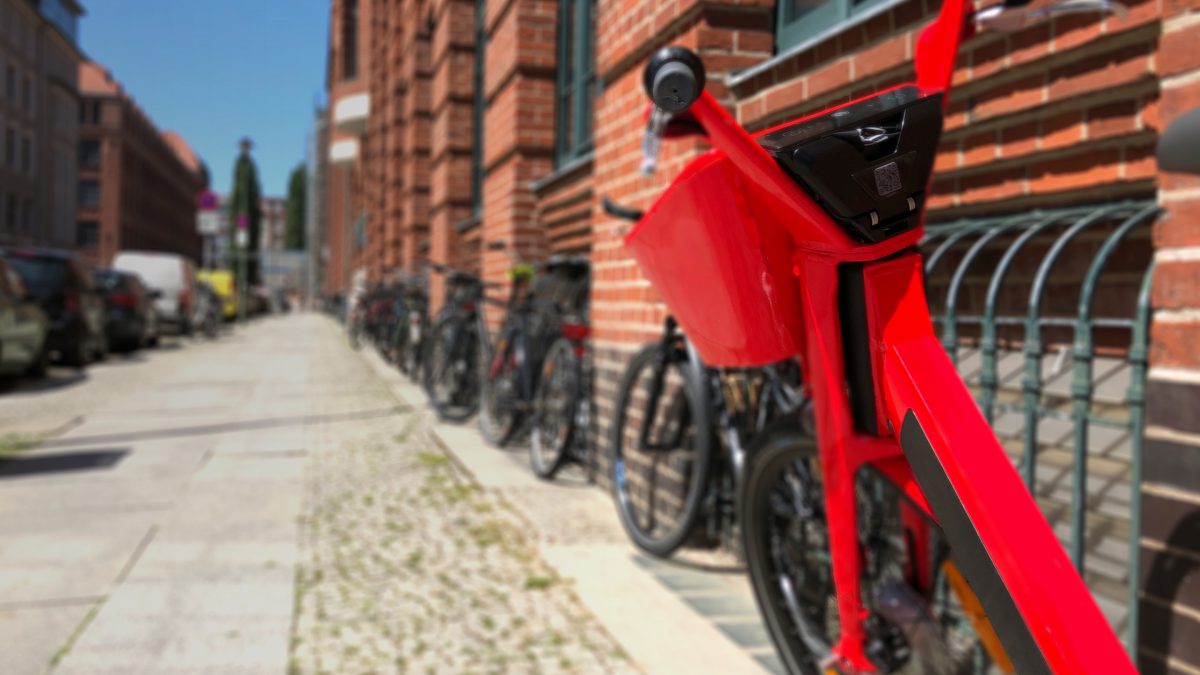That is actually quite easy to answer: No, they do not make Berlin a smart city.
And why is that?
The aim of this blog article is to explain briefly our perspective on the smart city and thus to explore how Uber’s Jump bikes fit into this concept.
Red rental electric bikes
Berlin is a growing city, the population is expected to increase by almost 11 percent by 2035. Along with this rise, the transport infrastructure needs adjustments and improvements to cope with these challenges in a sustainable way. These requirements are all collected under the term transport transition (“Verkehrswende”). The transport transition is not only an ecological issue but also a demographic necessity. Besides public transport, this topic also relates to concepts of the first and last mile. In addition, many transport transition projects deal with bikes and enhanced conditions for cyclists. At the same time, alternative mobility concepts are gaining in prominence. In particular, a market for rental bikes and other shared mobility services like rental motor scooters or rental e-scooters has arisen.
In Berlin, we have seen a multitude of different colors of rental bikes: yellow ones, which have already disappeared again, some orange, blue and green ones, which are all still there. In May 2019, another color joined them: The bright red “Jump” bikes from Uber can now be rented in Berlin.
The special thing about these Jump bikes is that they are electric and can drive up to 25km/h. They can be rented via the Uber app, the user just has to switch to “bike” in the menu. In other European cities, like Madrid or Paris, users can also already rent Jump e-scooters via the Uber app. The Jump bikes work as so-called “pedal assist” electric bikes, meaning the stronger you pedal, the more they gain in speed. The prices depend on the city in question. In Berlin, the price for the reservation is 1€, on top of that users are charged 0.10€ per minute for the ride. The area you can use the Jump bikes in is limited; in Berlin the borders of this area are similar to the Berlin S-Bahn Circle Line.
Now that we are on the same page here, let’s talk again about why these Jump bikes do not make Berlin smart in the smart city kind of way.
Smart as in …
In order to discuss to what extent Uber’s Jump bikes count as a solution toward a smart city, we want to take three dimensions into account: The first dimension refers to the actual problem the red rental bikes are presumably solving for the city and it citizens. The second dimension describes inclusion as a social aspect (who is it for?) and the third dimension takes a look at the financial concept behind it.
The problem dimension – The final mile
For the first dimension we want to take a look at the problem the shared mobility service presumably targets: the final mile. In urban areas the so-called “last mile” is a particular problem, for both delivery services and citizens. For the latter it applies, for example, to people using public transport who do not live near a train or bus station. In this case, they need to bridge the last mile with alternative solutions. Additionally, for people living in the outer circle of the city or the outskirts, the last-mile problem occurs since the connection to public transport is often rather poor. Thus, Jump bikes cannot be regarded a last-mile solution, since the bikes have not only to be booked separately, they are also only available within a limited area and not in the outskirts of the city.
The social dimension – Inclusion
With regard to the second, social dimension we want to take a look at the citizens and how shared mobility services relate to them. A smart city can be understood as an inclusive approach, meaning it includes all citizens no matter how much money they earn or which part of the city they live in. As mentioned above, Jump bikes (as with most of the rental bikes and other shared mobility services) can only be accessed within a limited area of the city, within the Berlin S-Bahn Circle Line.
What is also crucial when it comes to inclusion is the usage fee: As previously stated, users do not only pay for the ride, they also pay an additional fee for the reservation time. Let’s make this clear by way of an example: A user that lives a 10-minute bike ride from the train station would pay about 2€ for each bike ride. This would be 4€ per day for the first and final mile. Combined with an annual subscription for public transport (around 63€ per month as of July 2019), that amounts to 140€ per month. Presumably most citizens in Berlin cannot afford to use both services regularly.
Financial concept
The services are financed through the usage fees. The city and its administration itself neither profit from nor invest in this business. On the other hand, they hardly have any say in anything that has to do with the former aspects of final miles or inclusion (yet). And this is the other side of the coin: Berlin as a city is not able to decide on issues related to Jump bikes or any other new mobility service provider.
Politics might be able to allow rental bikes, e-scooters and other new mobility offers, but it does not have a stake in deciding about specifications. One exception here is the service provider Next Bike: The Berlin Senate is investing 7.5 million euros over five years in its network expansion. Next Bike has permanently installed bike stations where users can rent and park the bikes. Most of these stations are installed at train stations.
Outlook: Still on the way toward a smart city
All in all, the Jump bikes, just like any other shared mobility provider in Berlin, are a new mobility service operating within the area of the Berlin S-Bahn Circle Line, but after taking the three dimensions above into consideration they do not make Berlin a smart city. Selectively, Jump bikes may solve some individual problems, but they do not approach the entire picture. With its Jump bikes Uber does not deliver solutions for the city and its citizens’ problems.
Consequently, it is not possible for one new technology to make a city smart: a smart city concept builds on new connections, cooperations and business models.
A smart city approach focusing on solving problems should always have the respective problems in mind. Thus, it needs mutual solutions (e.g. co-creation solutions between different services and pay-per-mile models) connecting different services so as to reach a successful transport transition for both Berlin and its citizens.





